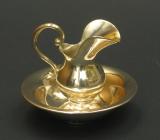1
Paul Aron's Art Collection3
Paul Aron's granddaughter, Evelyn Uditsky, describes the photograph that you see here: "I have here a picture of my grandfather's home in Germany, and he had a small Torah ark, and even a podium to pray at, and he had many of his religious pieces in that area, but they would have been all over the house."4
The picture shows Paul Aron's (1874-1957) devotion to his faith. He was a religious man, and he spent much of his time in prayer and study. The surroundings provide evidence of the collection of Jewish ceremonial art objects that the Arons kept in their home. A small Chanukah candelabrum rests on top of the Torah Ark. The Torah scroll is equipped with a decorative Torah pointer. A star-shaped Shabbat lamp hangs from the ceiling. Through this collection, Paul Aron was able to combine his devotion to the Jewish faith with his passion for art. Many of the objects from the Aron household, such as the Shabbat lamp that appears in the photograph, are now on display at the Aron Museum.5
As a young man, Paul set out to become an artist and was sent by his family to an art school in Zurich. Yet when his own father died in 1896, Paul's mother insisted that he return home. As the eldest son, he was expected to take over the family business.Paul returned to Frankfurt and stepped into his father's shoes. He became a businessman and ran the family's factory, Aron Sacks, which made jute bags and wagon covers. He married Karoline Levi, with whom he would have seven children. He continued to uphold the Orthodox faith and traditions of his family.
6
Paul seems to have abandoned his art practice when he returned to Frankfurt, finding a new outlet for his passion for art as a collector of Jewish ceremonial art objects.His daughter Judith remembered that her father would always bring new pieces into their home. The pieces were not only intended to be admired, but were also used by the family in their observance of Jewish rituals.
7
Judith particularly remembered celebrating Shabbat in her childhood home.The holiday of Shabbat is observed every week, from Friday at sundown until Saturday at sundown. It is a day of rest, when families and friends get together to feast, pray, learn Torah and sing.
Shabbat was a very significant day in the Aron household. It was also a weekly opportunity for Paul and his family to use the pieces in his collection.



